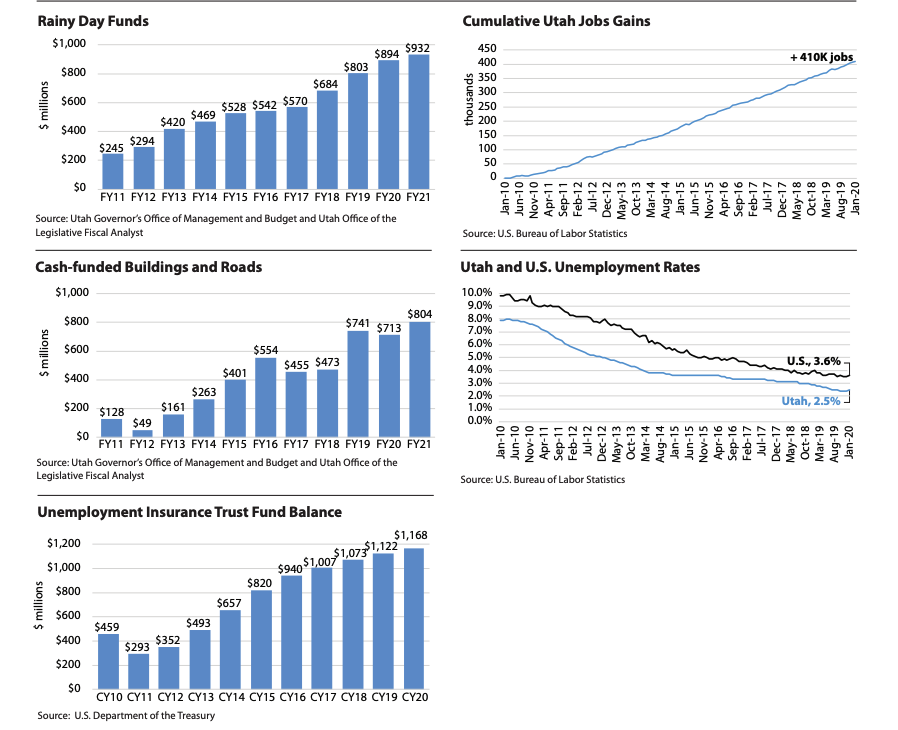By Sydnee Gonzalez and Spencer McWilliams
Utah Gov. Gary Herbert and leaders of the state coronavirus task force released “Utah Leads Together,” a government plan to diminish the economic hardships resulting from COVID-19, on March 24.
The plan has three phases — urgent, stabilization and recovery — which are aimed at helping businesses balance the wellbeing of employees with planning for continuing operations. The plan also is focused on ensuring that measures to protect public health are balanced with economic recovery.
“This dynamic plan provides a vision for Utah’s economic rebound as we carefully address the public health emergency before us,” Herbert said in a message to Utahns. “The plan aims to eventually return Utah to the record-setting economic growth it enjoyed before the pandemic.”
According to a March 24 press release, Utah is currently in the urgent phase of the plan, which is expected to last between eight and twelve weeks from March 16. During this phase, the state government officials are encouraging more aggressive social distancing measures and are planning to test around 4,000 people or more per day. Federal economic aid is estimated to be $2 trillion nationwide, and the state plans to utilize $24 million of Utah’s share towards COVID-19 and to delay tax payments.
Utah currently has significant reserves, including the unemployment insurance trust fund, to support the economy and mitigate impacts to critical public services like education, public safety, transportation and public health and social safety-net programs due to a historic decade of sustained economic growth.

(Courtesy Utah Leads Together)
The plan encourages residents to stay engaged with the economy and work together to keep every kind of business open and operating. In order to do so, state leaders have mapped out a general guideline to telework for workers in many different types of businesses to ensure health and safety for employees and customers.
These businesses include retail establishments, manufacturing, dining, work sites and hotels/accommodations.
The task force’s goal is to reduce the person-to-person transmission rate — or the number of people someone with the virus infects — to 1 within 30 days in order to avoid a hospital bed crisis. National estimates of transmission rates have been pegged at 1 to 3 in recent days, meaning one person with the virus typically infects three additional people. Current estimates suggest that to achieve the 1 to 1 goal, Utah must have no more than 800-1,000 new infections before April 30, according to the press release.
The Utah Leads Together plan acknowledges, however, that a characteristic of the urgent phase will be severe impacts to small businesses and nonprofits and layoffs for hourly and other workers.
“A cruel reality of a global pandemic is that it hurts some people and industries more than others,” reads the plan, with specific mentions of those with underlying health conditions as well as the retail, prepared food, travel, tourism, and transportation sectors. “Now is the time for all Utahns to find ways to share and serve.”
Small business owners in all 29 Utah counties are now eligible to apply for low-interest loans through the Small Business Administration as part of the state’s plan. Unemployment insurance and the Salt Lake City Emergency Loan Program are also available to help individuals who have been impacted by COVID-19 and are struggling financially.
Following the urgent phase, the stabilization phase of the state plan will last 10-14 weeks. This phase promises to accelerate economic recovery as the new interventions from the urgent phase take hold.
The main objectives during this phase are to prevent any loss of progress that is made during the urgent phase, to provide promising medical treatments and to continue towards complete economic recovery.
Characteristics of improvements from this phase include job losses slowing down and transmission rates of COVID-19 declining to less than one per infected person.
Finally, the recovery phase is expected to last only 8-10 weeks. State government plans hope to ensure control of the virus and a return to economic stability. According to the plan, expected characteristics of improvement in this phase are a COVID-19 transmission rate of near-zero and a growth in jobs.
Improvements in public health practices, high-risk populations continuing to take precautions, the lifting of travel restrictions and in-dining and entertainment venues resuming operations are just some of the practices that will factor into the improvements within the recovery phase.
The plan encourages Utahns to act on the “Beehive Mentality” by working together to flatten the infection curve and bolster Utah’s economy. It warns that failure to follow social distancing guidelines may result in government mandate of more extreme social distancing measures and a prolonged timeline.
“Times like these bring out the best in Utahns. We work together. We look out for each other. Combine that foundation with strong long-term fundamentals in Utah’s economy, and I am optimistic about Utah’s future. This is a time for Utah to shine,” said Herbert in a letter to Utahns.
For more information, visit coronavirus.utah.gov.




